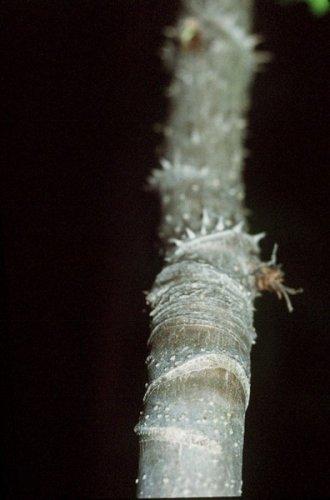You were challenged to identify National Park Mystery Plant 14 using this rhyme:
Pocking the ground at every 4th step, Satan hikes the trail with remarkable pep.
You were also told that it would be helpful to visualize a briskly-paced hike, and as the abstract implied, think in terms of "one-two-three-four, hit the dirt and walk some more."
The answer is the devil's walking stick. Here's how to derive that from the clues.
Satan is the devil. A staff or walking stick leaves pock marks (shallow pits) in a dirt trail. If the person or evil entity using the walking stick is moving along at a brisk pace and swinging the walking stick smoothly, the stick produces a pock mark every fourth step.
Here is some information you might find interesting.
Devil's walking stick (Aralia spinosa) goes by a large variety of other names, including Angelica tree, prickly ash, prickly elder, Hercule's club, pick tree, and shotbush. Some people who mistakenly believe that it has medicinal properties call it the "toothache tree."
This woody plant, which may grow as a large shrub or small tree in clonal thickets, has a spiny, typically branchless trunk with light brown bark, prickly stems, lacy compound leaves, showy creamy-white flowers, and purplish-black berries that are relished by birds.
Aralia spinosa acquired its devilish name(s) for good reason. There are viciously sharp spines on the trunk, leaf stalks, and leaf midribs.
Interestingly, the devil's walking stick has the largest leaves of any native tree in the continental United States. A single leaf may be as much as three feet long and two feet wide. It's hard to tell at a glance that this plant's leaves are unusually large because each lacy-looking compound leaf is bipinnate and consists of numerous two- to three-inch long leaf lets.
Aralia spinosa is admired for its exotic good looks and has been cultivated in this country, typically as a shrub border, for centuries. It is also a favorite of serious fall foliage fans. Leaf peepers appreciate the yellow-tinged bronze red or purple leaves that make the tree stand out in a strikingly pretty way.
The devil's walking stick prefers disturbed areas with deep, moist soils, and is often found growing along forest edges or as an understory plant in relatively open forests. Its range is quite large, primarily extending from New York and Pennsylvania on the Atlantic Coast southward as far as northern Florida and westward as far as Illinois and east Texas (though it's seldom found in the lower Mississippi River Valley). Because it has escaped from cultivation in various parts of the country, and can occupy some marginal habitats, you can also find it growing in parts of New England, the Great Lake states (especially Wisconsin and Michigan), and the Pacific Northwest.
Devil's walking stick can be found in numerous national parks, including -- to name just a few -- Gateway National Recreation Area (New York/New Jersey), West Virginia's New River Gorge National River, Great Smoky Mountains National Park (Tennessee/North Carolina), Big Thicket National Preserve in east Texas, and Olympic National Park in Washington.
Postscript: Before the plant's prickles harden, the young, tender leaves of the devil's walking stick can be finely chopped and boiled for use as a potherb/seasoning.




Add comment